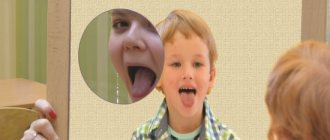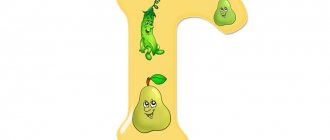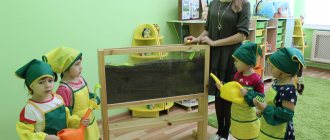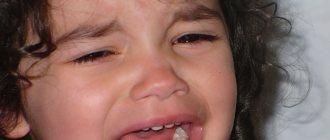The importance of speech development in children at preschool age
The formation of coherent speech is a complex developmental process that begins at birth and actively continues in preschool age. Children learn to express their thoughts using words, influence their environment, and receive a response to their thoughts or feelings.
Timely speech development helps:
- stimulate the functions of the brain and central nervous system, which are intensively formed at an early age;
- until the speech center in the brain fully matures, accumulate a vocabulary and learn to control the means of the native language;
- to form different types of thinking, receptivity to learning and education;
- expand your social circle outside the family, increase self-confidence;
- connect pronunciation with hearing, develop speech organs through articulation, pronunciation features (intonation, tempo, rhythm, timbre);
- explore the world, since speech allows the child to get an idea of the surrounding objects or phenomena;
- in the process of teaching primary schoolchildren to develop literacy, reading and writing skills.
In the experience of personality development, learning the native language occupies an important place: the mechanisms of the psyche change, a rational perception of the surrounding world is established.
Speech development tasks
At all stages of growing up, a child masters different levels of oral interaction: the babble of a baby a few months old, the first words and sentences of older children.
Speech expands the possibilities for knowledge. In addition to manipulating objects around him, the child begins to fantasize and learn new things from the stories of others or fiction.
What tasks are performed during speech development:
- master your native speech as a tool for communication and learning;
- enrich your vocabulary (know and use many words);
- learn to speak clearly and correctly, to conduct a dialogue;
- learn the culture of communication (listen to your opponent, do not interrupt, consistently express your thoughts);
- get acquainted with the basics of speech creativity (retelling, composing stories, plots about your impressions of the phenomenon seen);
- listen and understand fairy tales and stories from children's literature;
- remember the correct language structures for future literacy learning.
Features of speech development or what can be said about the components of speech activity?
M.R. Lvova noted that the components of speech activity include:
- speed of speech reactions during dialogue,
- selection of games that require the use of speech components,
- speed of word choice,
- features of statements.
And the conditions under which children’s speech is activated include: mastery of the language system at a certain speech level of development, the need and characteristics of communication in children, the inclusion of preschoolers in activities that are available for a specific age stage.
What factors influence speech development
Factors influencing the development of a child's speech.
A child’s mastery of oral speech is determined by the following conditions:
- Heredity, structure of speech organs. Incorrect anatomy of the organs of the articulatory apparatus and undeveloped facial muscles complicate the development of speech in children 1-3 years old. Drinking through a straw and inflating balloons help strengthen your facial muscles. Whereas physiological problems are solved by medical methods.
- Correct functioning of the central nervous system, speech zone of the brain. Disturbances in the functions of the nervous system or Broca's center are often accompanied by delayed speech development in children. To develop these functions, exercises for fine motor skills are used.
- Pregnancy, childbirth without complications. Research confirms that anemia during gestation, premature birth before 35 weeks, hypoxia and other pathologies delay speech development at an early age.
- Contact with parents and close relatives from the first days of life. The foundation for future communication and healthy development of the newborn is a sense of security, physical closeness to the mother, and provision of physical and emotional needs.
- Constant interaction between parents and child. He learns about communication from changes in facial expression, movements, and gestures. Then he begins to perceive addressed speech, distinguish between emotions and voice intonations. Therefore, it is recommended to pronounce your actions, call the baby by name, and do not ignore babbling or crying.
Kurgan City Innovation and Methodology Center
Even Leo Kanner (an Austrian and American psychiatrist, known for the first descriptions of childhood autism and subsequent work in this area, one of the founders of child psychiatry) noted speech characteristics characteristic of autism, such as its later development, echolalia (including severely delayed time), difficulties in using pronouns (children often said “you” instead of “I” and vice versa).
Indeed, the development of speech, both expressive and impressive, can be severely delayed in a child with autism. This usually becomes noticeable in the second year of life. However, even at an earlier age, it is possible to detect features that distinguish the speech of a child with ASD from a child with normal development.
Early development in autism is characterized by the following features of prelinguistic development: undifferentiated crying, difficult to interpret, humming is limited or unusual (more like a squeal or scream), and there is no imitation of sounds.
Thus, autistic children aged 18–36 months use atypical nonverbal vocalizations (squealing) significantly more often than their typically developing peers and children equal to them in speech development.
Although the speech of children with ASD may be less developed than that of children with language delay (without autism), there are no significant differences in the quality of language delay. Autistic children and children with speech delay 22-30 months use words from various categories to the same extent (sounds, animals, transport, toys, food and drinks, body parts, household items, furniture, places, people, games and activities , actions, descriptions, pronouns, prepositions, articles). Children of this age from both groups use equally few words to denote desires, emotions and mental states in general. The level of complexity of grammatical structures is the same in these groups.
There are studies both confirming data that speech development in children with autism follows the same pattern as in other groups of children, and showing differences between speech development in different groups (children with early childhood autism, with Asperger's syndrome, specific speech delay and typically developing children).
Thus, in a study of speech development in preschoolers with ASD, it was shown that in autistic children, understanding words was more delayed than pronouncing words. However, in general, impressive speech in children with autistic disorders developed earlier than expressive speech, as happens normally. Also, the group of children with ASD lagged behind typically developing children in speech development.
Researchers have linked language development in autism to early imitation and divided attention abilities. Thus, children who had almost or no episodes of spontaneous imitation showed a decrease in verbal communication skills. This is explained by the fact that at the prelinguistic level, communication is based on nonverbal behavior, such as gaze, gestures and pantomime, and facial expression. Also, in the early stages of development of speech skills, speech accompanies the child’s play based on imitation and develops with the help of it.
In severe cases, children with autism do not begin to speak at all, but even then they are able to use alternative means of communication (writing, gestures, specially designed pictograms and cards).
At the same time, some children with autism demonstrate early and rapid speech development. This is more typical for Asperger's syndrome. The child can memorize large texts and reproduce them almost word for word, use phrases and expressions inherent in the speech of adults. However, opportunities for productive dialogue remain limited. Understanding speech is largely difficult due to difficulties in understanding figurative meaning, subtext, and metaphors.
Approximately 25-30% of children with autism spectrum disorder begin to speak but then lose their language skills. This often occurs between 15 and 24 months, and regression may occur suddenly or appear gradually. Simultaneously with the regression of speech skills, there may be a loss of the ability to use gestures and a loss of social skills (eye contact, reaction to praise). Sometimes the regression is superimposed on the child’s pre-existing characteristics characteristic of autistic disorders. The mechanism underlying autistic regression is unknown. Potential factors include accelerated head growth, genetic disorders, seizures or other electrophysiological abnormalities, effects of vaccinations, digestive disorders, and immune deficiencies. However, to date, none of these factors have been proven to have a direct connection with regression.
Features of expressive speech
Speech disorders are most clearly visible after 3 years. For children with autism spectrum disorders, delayed or immediate echolalia, a tendency to repeat ready-made phrases without independently constructing sentences, difficulty starting and maintaining a dialogue, and changing pronouns are typical. In children's speech, there are frequent rearrangements of sounds and incorrect use of prepositional constructions.
Features of the intonation side of speech also distinguish these children. They often find it difficult to control the volume of their voice; their speech is perceived by others as “wooden,” “boring,” or “mechanical.” The tone and rhythm of speech are disturbed.
Speech disorders in autism can be divided into five groups according to genesis and pathogenetic level:
• speech disorders as a consequence of delayed development (tongue-tied, physiological echolalia, poor vocabulary, etc.);
• speech disorders due to delayed development of self-consciousness in the form of incorrect use of pronouns and verb forms;
• speech disorders of a catatonic nature (verbigeration, echolalia, egocentric, fading, inner speech, mutism, chanted, extended or accelerated sound pronunciation, paralinguistic disorders of tonality, tempo, timbre of speech, etc.);
• speech phenomena due to mental regression (appearance of speech at the preverbal phonemic level;
• speech disorders associated with the pathology of the associative process (violations of the semantic side of speech in the form of incomplete, inconsistent associations, contamination, etc.).
Formal features of speech of children with ASD
The presence of echolalia is one of the most common speech characteristics in autism. Typically, echolalia is described as an uncontrolled automatic repetition of words heard in someone else's speech. These repetitions can occur immediately after what was heard (immediate echolalia) or noticeably later (delayed echolalia).
Some authors believe that echolalia, as repetition without meaning or apparent purpose, is an indicator of the severity of the disorder and makes adaptation difficult. In accordance with this paradigm, ways to correct echolalia are being developed.
At the same time, other researchers consider echolalia to be a primitive attempt to maintain social contact in a situation where the child is faced with speech stimuli that are inaccessible to him, and consider this a good prognostic sign.
According to this paradigm, echolalia can be divided into communicative and non-communicative. While non-communicative echolalia is not goal-directed and is more used by the child to regulate his state, gain pleasure or simply “test” words, communicative echolalia can be used to convey information, ask for help, protest or give instructions. Moreover, children with autism spectrum disorders use more communicative echolalia than non-communicative echolalia.
General stereotyping, characteristic of children with ASD, is presented in speech not only in the form of echolalia, but also in the form of more complex verbal rituals. Verbal rituals are fixed sequences of utterances that the child constructs as if he feels compelled to complete them in a certain order. In this case, the child can not only perform verbal rituals himself, but also force others to do so.
Neologisms are words that do not exist in languages known to the child; the child constructs them himself. There are passive neologisms (meaningless sound combinations) and active ones (having a certain meaning). Typical language development also includes neologisms (called physiological ones), which can occur in children under five years of age. Idiosyncratic speech involves actual words and phrases used or combined by a person in a way that he could not have learned from others. At the same time, the formed phrases serve to convey a specific meaning.
Children with autism use more neologisms and idiosyncratic speech than their normative peers or children with mental retardation at the same level of language development. Moreover, the frequency of use of idiosyncratic speech in autistic children increases with the complexity of speech, while in children with mental retardation the frequency of such phenomena decreases as speech skills develop.
The replacement of personal pronouns in children with autism was noted by Leo Kanner. Indeed, personal pronouns are complex abstract constructions that cannot be learned through direct imitation. To use personal pronouns correctly, a child must understand that there are different roles in a conversation (the speaker, the one being spoken to, just the listener, third parties being spoken about), and the use of pronouns depends on the role of the person in the dialogue. Apparently, errors in the use of pronouns are associated with a delay in the formation of self-consciousness. The sense of self and other, overcoming children's egocentrism, and the ability to joint attention are also important factors in understanding the use of personal pronouns, which may be impaired in children with autistic disorders.
Impaired or unusual use of prosodic components of speech (stress, intonation, tempo, rhythm, speech volume) is often associated with autistic disorders. Prosody plays a big role in communication, helping to clarify the meaning of a phrase (for example, when emphasizing a specific word in a sentence), identifying interrogative and affirmative statements, separating semantic parts within a statement, and conveying the emotional context of the phrase.
The speech of people with autism is often characterized as emotionally poor, monotonous, “mechanical,” and with little variation in tempo and volume. If there is intonation in speech, it may be strange, pretentious or exaggerated. The greatest difficulties are identified in people with autism spectrum disorders in understanding and using intonation stresses, that is, highlighting certain words or phrases in a sentence. Moreover, these difficulties are identified not only in children, but also in adolescents and even adults with autistic disorders.
Modifications and uses of language depending on social context are called pragmatic aspects of speech. The use of intonation stress has a lot to do with the social use of speech. In order to highlight any part of a phrase intonationally, it is necessary to understand that it needs to be highlighted because listeners can interpret the phrase in different ways. Children with autism may have difficulty understanding this and may not pay attention to intonation when speaking. The opposite effect of not understanding which part of a phrase should be highlighted is that children with autism highlight several parts of the phrase, which is why the speech may have a scanned character. Intonation accents may also be placed involuntarily due to other expressive speech disorders
People with autism spectrum disorder are characterized by impaired social and emotional reciprocity. They are also less able to recognize the emotional component of speech, conveyed through prosodic components, and are less able to convey emotion in speech themselves. Apparently, these phenomena are interrelated, and disturbances in the emotional prosody of speech are a manifestation of social difficulties.
In addition to the specific speech features characteristic of autistic disorders, children with autism may have speech impairments characteristic of delayed speech development in general: a smaller active and passive vocabulary, syntactic difficulties. At the same time, a connection was traced between syntactic and lexical difficulties. It has also been shown that the overall profile of these difficulties (if any) in children with autism spectrum disorder is similar to that of children with language impairment.
Features associated with the social use of speech
Regardless of the level of speech development, with autism, the ability to use it for communication is primarily affected. The communicative use of speech involves its focus on another person in order to inform him or receive some information, help, or attention.
Another aspect of the social use of speech is the ability to communicate only for a social purpose, that is, to speak not in order to get something, but to maintain personal communication.
It has been shown that the main pattern of interaction with other people in children with autism is “manipulation,” when children’s requests to others are motivated solely by the need to satisfy their own needs while completely ignoring the desires of their partner.
There is a hypothesis that explains the difficulties of social communication in children with autism by the underdevelopment of their so-called model of mind. A model of mind is a system of representations of mental phenomena that intensively develops in childhood. Having a mental model means being able to perceive both your own experiences (beliefs, intentions, knowledge, etc.) and the experiences of other people, which allows you to explain and predict their behavior.
The absence or insufficient development of a model of mind may explain many of the social deficits in autism. It also explains the inability to understand hidden meanings, hints and implicit rules of social communication.
Children with ASD often show a lack of understanding of social rules and the social consequences of their actions, including in speech. Children may ask questions that are inappropriate or inadequate to the situation, and may not correlate their statements with social norms. Also, children with ASD may avoid social contacts without a specific goal, which significantly narrows their social circle. These problems fall within the realm of qualitative impairments in socialization, which are diagnostic criteria for autistic disorders.
Peculiarities of speech understanding in children with ASD
Children with autism are also limited in their ability to understand speech. Around the age of one year, when typically developing children love to hear people talk to them, children with autism spectrum disorder pay no more attention to speech than to any other noise. For a long time, the child is unable to follow simple instructions and does not respond to his name.
The development of verbal and nonverbal communication in children with autism is influenced by perceptual characteristics. While the corresponding analyzers are intact, up to 90% of people with ASD have certain peculiarities of perception, primarily auditory, visual and tactile, as well as hyposensitivity (reduced sensitivity) to pain. In this case, both hypo- and hypersensitivity to stimuli may be present simultaneously. Very often there is a lack of selective attention to speech sounds.
There is evidence that hyporesponsiveness to social and nonsocial stimuli is associated with the mental age of a child with autism. Children with a low mental age demonstrated a greater lack of response to stimuli (more often social ones) compared to children with developmental delays and typically developing children. Hyporesponsiveness to stimuli decreased with increasing mental age. Hyporesponsiveness to social and nonsocial stimuli may predict poorer language and divided attention development in children with autism.
Adolescents with high-functioning autism and Asperger syndrome demonstrate difficulty filtering auditory stimuli and less integration of auditory and visual information in speech than normotypical adolescents. Also, to a lesser extent than typically developing adolescents, they distinguish between speech phonemes typical of their native language and musical rhythms typical of a culture. In general, adolescents with autism spectrum disorders demonstrate more impairments in the perception of speech stimuli than music stimuli. At the same time, these indicators vary widely within the group of adolescents with ASD.
Speech features in autistic disorders
are manifestations of qualitative violations of communication and socialization. The general stereotypical behavior and activity of people with autism is reflected in such speech phenomena as echolalia and verbal rituals. Thus, in speech with ASD one can see manifestations of the entire autistic triad.
Speech development in children with autism is most often delayed, and the pattern of this delay has both similar features to delayed speech development in children without autism, as well as specific features that are noticeable even at the prelinguistic level. In some cases, during speech development, a specific regression of speech skills can be noted, often accompanied by a general regression in the child’s development. The reasons for such regression have not yet been established, but various hypotheses constantly arise about the connection of some external and internal factors with regression.
Among the features of expressive speech in autism spectrum disorders, it is customary to highlight echolalia, verbal rituals, the use of neologisms and idiosyncratic speech, and incorrect use of personal pronouns and verb endings. The speech of people with autistic disorders may also be unusual in its paralinguistic components: intonation, tempo, rhythm and volume. Qualitative communication impairments also manifest themselves in the difficulties of communicative use of speech by people with ASD. Using speech for communication, taking into account the social context of a conversation, and communicating solely for a social purpose are difficult for children and adolescents with autism.
The ability to understand speech is also limited in children with autism, and these limitations are largely related to the characteristics of sensory perception in general. Difficulties in filtering speech stimuli, hypo- and hypersensitivity to sensory input in children with autism complicate the development of impressive speech.
Understanding the characteristics and speech disorders of children with autism spectrum disorders not only improves the ability to diagnose these disorders, but also helps in the process of correction, training and interaction with children.
Prepared by speech therapist TPMPC, O. V. Mishenina.
Psychological characteristics and stages of speech formation in preschool children
In the first years of life, the child develops mentally and physically, learns to control his body, think, and masters his native language. The formation of speech occurs sequentially; different age intervals have their own norms.
The ability to speak is an acquired skill that is developed in all children according to a similar scenario. In order to promptly notice deviations in speech development, it is necessary to know the patterns of mental maturation at an early age.
How a child’s speech is formed from birth to 3 years
In the first year after birth, all systems of the newborn actively develop: the structure of the brain matures and becomes more complex, phonemic hearing is formed, and the speech apparatus is trained during crying or involuntary sounds.
Stages of child speech development.
What is the initial stage based on:
- listening to everyday sounds, spoken speech and one’s own voice;
- imitation of an adult (repetition of heard sounds, syllables, and, at the age of about 12 months, words);
- the basics of understanding the meaning of what was said (mainly through emotions, intonation and facial expressions);
- the state of the articulatory apparatus (determines coherence in pronunciation, mobility of speech organs).
In the second year of life, there is a leap in the development of active speech.
The following is typical for communication at this age:
- attempts to use words meaningfully (to name an object);
- up to 1.5-1.8 years there are no common sentences, they are replaced by 1 word (“Drink” as a request);
- at 1.8-2 years the composition of phrases expands, but there is still no grammatical connection between words;
- vocabulary increases (100-300 words depending on the conditions, frequency and quality of communication with adults);
- the development of articulatory organs continues, but the voice has not yet become stronger;
- intonation is mastered;
- individual sounds are pronounced incorrectly (vowels are softened, consonants are skipped, syllables are confused), words are simplified (“Beep” instead of “Machine”).
Development of child speech from 3 to 4 years old
In the third year of life, the cognitive function of speech increases. The child becomes interested in the world around him, begins to ask simple questions, and engages in dialogue with peers.
The speech development of a three-year-old child includes the following stages:
- vocabulary is enriched (2-3 times compared to two years of age);
- verbs are used more often (up to 30% of the active vocabulary), prepositions and pronouns;
- there are errors in agreeing the gender of adjectives for naming objects;
- complex non-conjunctive sentences appear in speech (by the end of 3 years - complex sentences);
- listening comprehension of children's literature improves;
- the speech apparatus becomes mobile, but speech coherence and voice volume remain weak;
- when pronounced, long words with a complex structure are often shortened, syllables are swapped or dropped out;
- memory improves, creative thinking and imagination begin to develop;
- attention remains unstable, the child is distracted.
Interest in surrounding objects stimulates the preschooler to communicate with adults and be the first to start a conversation. In dialogue, the child learns to reason and begins to determine the simple relationship between phenomena.
What features of speech development distinguish the 4-year stage:
- the ability to select names for any objects or actions increases, including those that do not constantly surround the child;
- the arsenal of words is expanding (adjectives, numerals, adverbs, pronouns are actively used);
- retelling events or someone else's speech, talking about one's impressions remain inaccurate due to the inability to correctly choose the right words;
- illogicality and inconsistency of presentation remain, but the grammatical structure of speech improves;
- communication remains situational, requires clarification, the story is tied to the situation;
- memorization of poems, riddles, fairy tales improves, the child easily repeats them, but mostly does not understand the meaning;
- the speech apparatus is improved at an individual pace (by the end of 4 years, children can already speak clearly, intelligibly, or continue to simplify sounds).
Development of speech in a 3-4 year old child.
Formation of speech skills in children from 4 to 5 years old
At the age of five, a preschooler becomes receptive to the social environment. There is an interest in the development of speech hearing through word creation, attempts to rhyme or singing. The formation of speech occurs intensively, the child imitates the manner of communication in the family or kindergarten.
What stages of speech development do 5-year-old children go through:
- the colorfulness and variety of speech increases (in addition to the names of objects, the child knows their signs and is able to logically connect several objects with each other, relying on properties);
- attention does not dissipate, becomes stable;
- the vocabulary is replenished to 2.5-3 thousand words, which stimulates the development of monologue skills, but increases the number of errors and inconsistent phrases in speech;
- the speech organs are sufficiently trained for correct pronunciation, the coherence and clarity of sounds improves, speech becomes understandable to strangers and other children;
- in 30% of cases there are difficulties in pronouncing the sounds r, l, hissing;
- phonetic hearing develops, the ability to distinguish the subtleties of pronunciation (voice pitch, timbre, intonation, tempo).
Features of speech development of a preschooler aged 5-7 years
Children of senior preschool age master coherent speech and compose a monologue from complex sentences and extended phrases. People around you understand the child without further questions.
Signs of the formation of contextual speech in children 6 years old:
- abstract logical thinking develops, understanding of connections and relationships between phenomena, objects, people improves;
- the vocabulary is replenished with forms of already familiar words (prefixes or suffixes are added), 4-6 thousand words are actively used;
- the child operates with generalizing words, collects words into groups based on a common property, and is able to select pairs of antonyms;
- the number of grammatical errors decreases;
- the development of the basic functions of the articulatory organs and mobile muscles of the face is completed, which is why sounds are pronounced clearly;
- With regular implementation of developmental oral exercises, by the age of 7 it is possible to improve the pronunciation of hissing sounds, r, l.
The speech of a seven-year-old child is practically no different from that of an adult.
Creative methods and techniques.
Development at this age is aimed at consolidating the following skills:
- The stock of words that are used daily continues to expand, and the child divides the same concepts according to characteristics (winter or summer clothes);
- means of expression are used (metaphors, epithets, comparisons), words in a figurative meaning (light ball or light hand);
- the monologue becomes detailed and logical, the child does not jump from one thought to another;
- grammatical errors occur rarely, mainly in the absence of prompts from adults;
- the voice becomes loud, the pronunciation is clear, while the child controls the intonation and tempo;
- Emotionality, personal attitude and point of view appear in statements, and individuality actively develops.
Formation of word formation skills
At the age of 5, the child begins to use all the main parts of speech in communication. He carries out the gradual formation and development of word formation in preschoolers. Children are in the process of activating their vocabulary, and children begin to use words meaningfully. Preschoolers improve their word inflection.
5-6 years is the period of active development of the phonetic side of speech. Children already have the ability to divide words into syllables and fill words with sounds. Mistakes are made only in words unfamiliar to children.
Parents' activity in the development of their child's speech
Parents are the first to introduce their newborn to communication. By observing the stages of speech development every day, they can notice violations in time and correct them.
To help a preschooler’s speech development, at home parents need to:
- from the first days pronounce words clearly, do not distort sounds when imitating baby babble;
- use a lot of words, name surrounding objects, describe everyday actions to introduce the child to different concepts;
- in the form of a game, invent new word forms with the preschooler to understand their native language;
- enrich speech with emotions, accompany spoken words with expressive facial expressions and gestures (smile = joy, frown = sadness);
- introduce children's books, tell short stories, setting an example of a coherent monologue, invite the child to come up with a continuation or retell the plot.
How to help young children develop speech
To stimulate the formation of speech from an early age, it is necessary to develop all modes of perception. In the first years, the child learns about the world around him through sensations, his own actions and the feedback he receives.
Recommendations for speech development through the sensory system:
- Touch. Tactile senses give the first ideas about life. It is important to constantly touch the newborn, massage, and exercise. It is also recommended to introduce him to textures: choose toys from different materials, offer to touch water, grass or flowers outside, cereals or sand.
- Vision. Teaches you to focus, concentrate, pay attention to an object and hold it with your gaze. In addition to the mobile or the bumpers in the crib, it is also necessary to show the situation in the apartment and introduce objects (cars, trees, birds, etc.) on the street.
- Hearing. It is recommended to create a rich sound space: everyday sounds, music, singing. From birth, you are required to constantly talk to your child, comment on your actions, and name objects around you. It is important to respond to babbling and repeat sounds in order to stimulate imitation of adult speech.
- Taste. When offering an unfamiliar product, you need to name it, describe its taste (sweet applesauce), properties (cottage cheese is made from milk given by a cow). This will introduce the child to new concepts.
- Smell. Smells are associated with the objects they correspond to. Through the sense of smell, the child learns to distinguish between pleasant and unpleasant sensations and expands the sensory range.
- Motor skills. Mobility contributes to understanding the world, so movement should not be limited. In a safe space, self-confidence increases, curiosity and play skills develop. The connection between fine motor skills and speech has been scientifically proven. Finger games, any exercises with small objects, everyday activities (tying shoelaces, eating independently with a spoon) contribute to the development of precision of movements and pronunciation.
Methods of speech development in preschoolers.
The importance of speech communication in preschoolers
The development of speech in preschoolers helps to expand the social circle of children of older preschool age. They talk a lot with family and close adults. Their speech becomes more expressive and has its own characteristics. Their communication with unfamiliar adults also develops. With the help of speech, children of senior preschool age are actively involved in communication with other children during play and independent activity.
The child's speech is often accompanied by objective actions. For example, a child takes a toy and begins to comment on his actions. Such a statement and such communication may seem to be simply a statement of the child’s action. But this form of speech plays a huge role in the development of a child’s thinking. This shows that the preschooler’s verbal communication is expanding, the baby begins to think and reflect using words and phrases. Features of speech development in this case show the maturity of the thinking of a child of senior preschool age.
Older preschoolers are interested in the speech and statements of adults. They listen carefully, noting only statements about themselves, not only speech that is addressed directly to them, but also listen with interest when adults speak with other children and with each other.
Until the end of the visit to the preschool educational institution, the verbal communication of a preschooler of senior preschool age can remain at the level of situational communication. In most cases, children of senior preschool age have not developed verbal communication on personal topics at all. And thus, they communicate purely emotionally and directly, which by and large characterizes the characteristics of communication of very young children. In behavior, preschoolers, of course, are not like babies, but they like it more when an adult simply strokes and caresses them, and in verbal communication they are often embarrassed, withdrawn into themselves, or even refuse to communicate. This is natural for a baby under one year old, but when this form of communication persists up to 5 years, it should be alarming, it indicates a developmental delay and shows that speech is not fully formed.
The majority of children of senior preschool age have speech development disorders. Children may comment on their actions during certain activities, but most often only when asked. Children most often do not show their own initiative in speech.
Methods of speech development in preschoolers
Preschoolers learn their native language in different ways. Communication is the basis of speech development in children over 3 years old, therefore, in a group, speech development occurs faster. Games with peers always require comments, explanations, and questions.
Other tips on developing speech skills for kindergarten teachers:
- observe the world - not only show surrounding objects, but also pictures, books, films, etc.;
- come up with your own stories - the teacher tells the beginning of the story, describes a phenomenon or toy, then invites preschoolers to compose a continuation;
- reading children's works - teaches attention, develops listening skills, sometimes after reading children are asked to retell it in their own words;
- develop diction - dialogues, word creation, short poems with clear pronunciation of sounds in order to train the articulatory apparatus;
- gaming methods - didactic games, dramatizations teach monologue and colloquial speech, communication culture, and enrich vocabulary.
These methods help consolidate acquired skills and expand the child’s communication capabilities.






